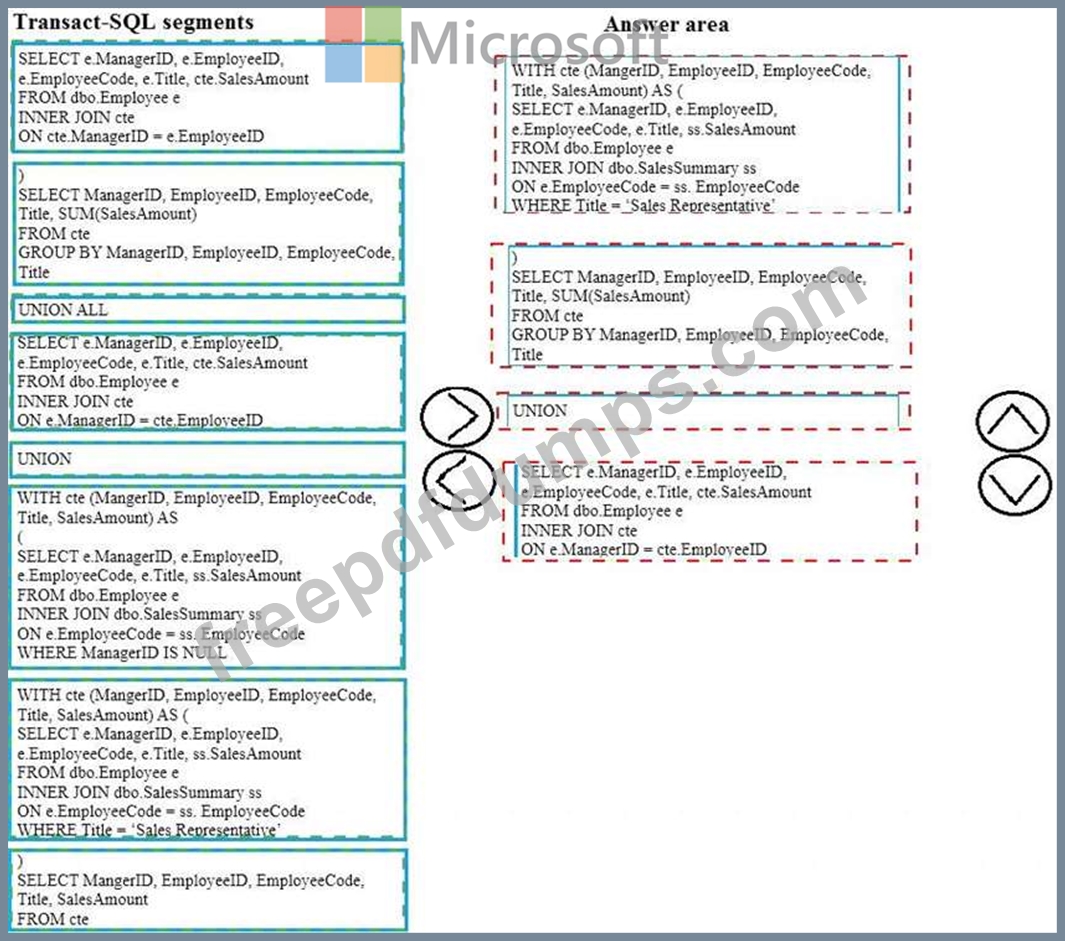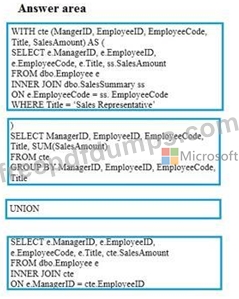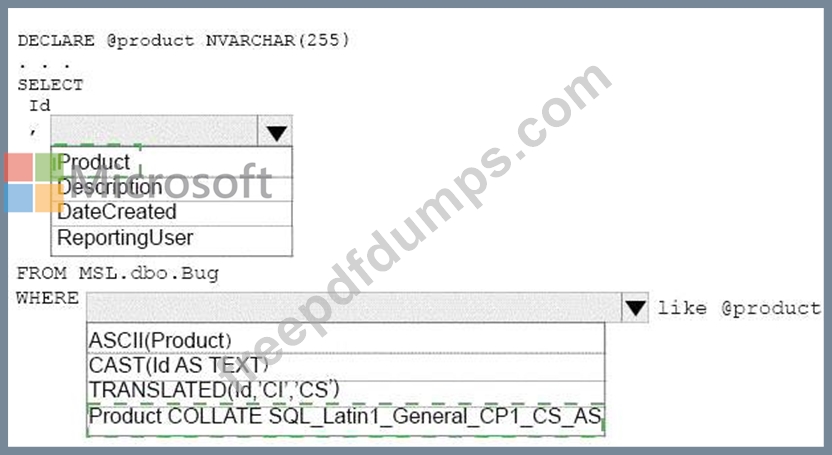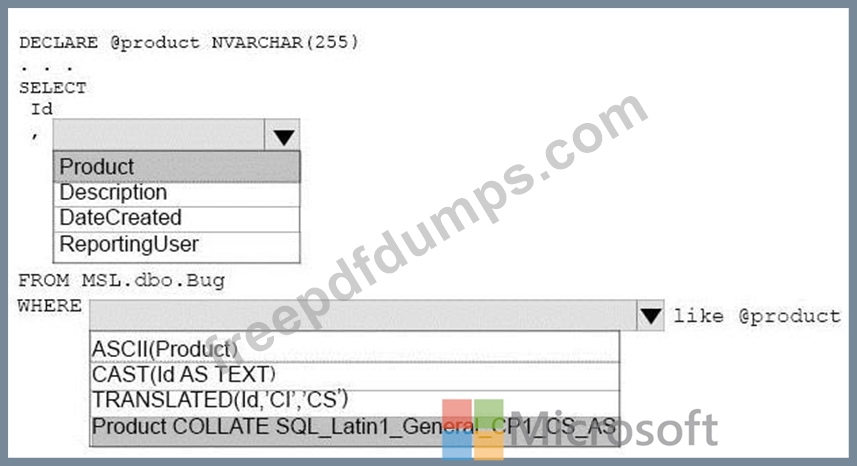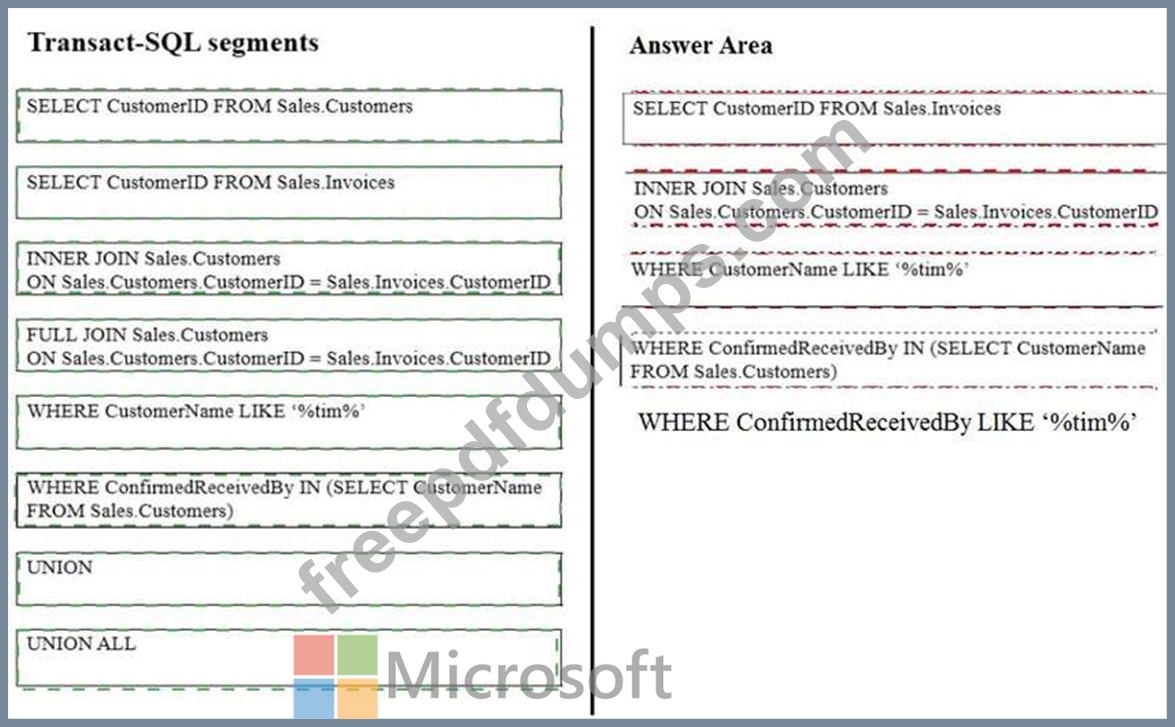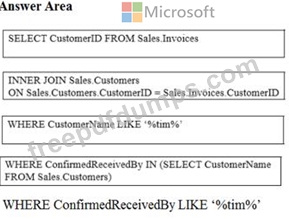070-761 Exam Question 51
Note: This question is part of a series of questions that use the same scenario. For your convenience, the scenario is repeated in each question. Each question presents a different goal and answer choices, but the text of the scenario is exactly the same in each question in this series.
Start of repeated scenario
You have a database that contains the tables shown in the exhibit. (Click the Exhibit button.)
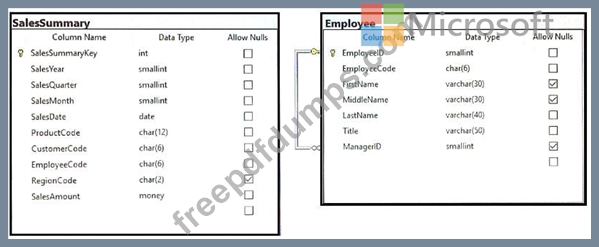
You review the Employee table and make the following observations:
- Every record has a value in the ManagerID except for the Chief Executive Officer (CEO).
- The FirstName and MiddleName columns contain null values for some records.
- The valid values for the Title column are Sales Representative manager, and CEO.
You review the SalesSummary table and make the following observations:
- The ProductCode column contains two parts: The first five digits represent a product code, and the last seven digits represent the unit price. The unit price uses the following pattern: ####.##.
- You observe that for many records, the unit price portion of the ProductCode column contains values.
- The RegionCode column contains NULL for some records.
- Sales data is only recorded for sales representatives.
You are developing a series of reports and procedures to support the business. Details for each report or procedure follow.
Sales Summary report: This report aggregates data by year and quarter. The report must resemble the following table.

Sales Manager report: This report lists each sales manager and the total sales amount for all employees that report to the sales manager.
Sales by Region report: This report lists the total sales amount by employee and by region. The report must include the following columns: EmployeeCode, MiddleName, LastName, RegionCode, and SalesAmount. If MiddleName is NULL, FirstName must be displayed. If both FirstName and MiddleName have null values, the world Unknown must be displayed/ If RegionCode is NULL, the word Unknown must be displayed.
Report1: This report joins data from SalesSummary with the Employee table and other tables. You plan to create an object to support Report1. The object has the following requirements:
- be joinable with the SELECT statement that supplies data for the report
- can be used multiple times with the SELECT statement for the report
- be usable only with the SELECT statement for the report
- not be saved as a permanent object
Report2: This report joins data from SalesSummary with the Employee table and other tables.
You plan to create an object to support Report1. The object has the following requirements:
Sales Hierarchy report. This report aggregates rows, creates subtotal rows, and super-aggregates rows over the SalesAmount column in a single result-set. The report uses SaleYear, SaleQuarter, and SaleMonth as a hierarchy. The result set must not contain a grand total or cross-tabulation aggregate rows.
Current Price Stored Procedure: This stored procedure must return the unit price for a product when a product code is supplied. The unit price must include a dollar sign at the beginning. In addition, the unit price must contain a comma every three digits to the left of the decimal point, and must display two digits to the left of the decimal point. The stored procedure must not throw errors, even if the product code contains invalid data.
End of Repeated Scenario
You need to create the query for the Sales Managers report.
Which four Transact-SQL segments should you use to develop the solution? To answer, move the appropriate Transact-SQL segments from the list of Transact-SQL segments to the answer area and arrange them in the correct order.
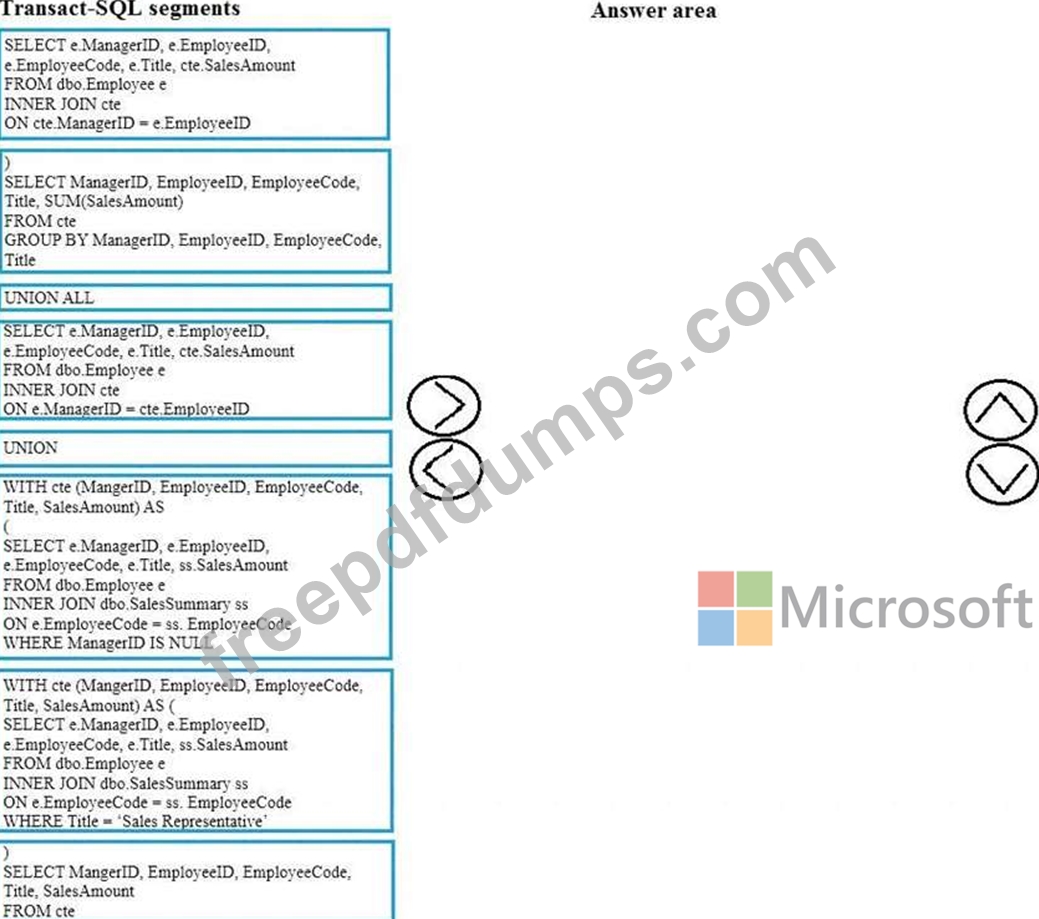
Start of repeated scenario
You have a database that contains the tables shown in the exhibit. (Click the Exhibit button.)

You review the Employee table and make the following observations:
- Every record has a value in the ManagerID except for the Chief Executive Officer (CEO).
- The FirstName and MiddleName columns contain null values for some records.
- The valid values for the Title column are Sales Representative manager, and CEO.
You review the SalesSummary table and make the following observations:
- The ProductCode column contains two parts: The first five digits represent a product code, and the last seven digits represent the unit price. The unit price uses the following pattern: ####.##.
- You observe that for many records, the unit price portion of the ProductCode column contains values.
- The RegionCode column contains NULL for some records.
- Sales data is only recorded for sales representatives.
You are developing a series of reports and procedures to support the business. Details for each report or procedure follow.
Sales Summary report: This report aggregates data by year and quarter. The report must resemble the following table.

Sales Manager report: This report lists each sales manager and the total sales amount for all employees that report to the sales manager.
Sales by Region report: This report lists the total sales amount by employee and by region. The report must include the following columns: EmployeeCode, MiddleName, LastName, RegionCode, and SalesAmount. If MiddleName is NULL, FirstName must be displayed. If both FirstName and MiddleName have null values, the world Unknown must be displayed/ If RegionCode is NULL, the word Unknown must be displayed.
Report1: This report joins data from SalesSummary with the Employee table and other tables. You plan to create an object to support Report1. The object has the following requirements:
- be joinable with the SELECT statement that supplies data for the report
- can be used multiple times with the SELECT statement for the report
- be usable only with the SELECT statement for the report
- not be saved as a permanent object
Report2: This report joins data from SalesSummary with the Employee table and other tables.
You plan to create an object to support Report1. The object has the following requirements:
Sales Hierarchy report. This report aggregates rows, creates subtotal rows, and super-aggregates rows over the SalesAmount column in a single result-set. The report uses SaleYear, SaleQuarter, and SaleMonth as a hierarchy. The result set must not contain a grand total or cross-tabulation aggregate rows.
Current Price Stored Procedure: This stored procedure must return the unit price for a product when a product code is supplied. The unit price must include a dollar sign at the beginning. In addition, the unit price must contain a comma every three digits to the left of the decimal point, and must display two digits to the left of the decimal point. The stored procedure must not throw errors, even if the product code contains invalid data.
End of Repeated Scenario
You need to create the query for the Sales Managers report.
Which four Transact-SQL segments should you use to develop the solution? To answer, move the appropriate Transact-SQL segments from the list of Transact-SQL segments to the answer area and arrange them in the correct order.

070-761 Exam Question 52
Note: This question is part of a series of questions that use the same or similar answer choices. An answer choice may be correct for more than one question in the series. Each question is independent of the other questions in this series. Information and details provided in a question apply to that question.
You have a database for a banking system. The database has two tables named tblDepositAcct and tblLoanAcct that store deposit and loan accounts, respectively. Both tables contain the following columns:

You need to determine the total number of customers who have only loan accounts.
Which Transact-SQL statement should you run?
You have a database for a banking system. The database has two tables named tblDepositAcct and tblLoanAcct that store deposit and loan accounts, respectively. Both tables contain the following columns:

You need to determine the total number of customers who have only loan accounts.
Which Transact-SQL statement should you run?
070-761 Exam Question 53
Note: This question is part of a series of questions that present the same scenario. Each question in the series contains a unique solution that might meet the stated goals. Some question sets might have more than one correct solution, while others might not have a correct solution.
After you answer a question in this section, you will NOT be able to return to it. As a result, these questions will not appear in the review screen.
You have a database named DB1 that contains two tables named Sales.Customers and Sales.Orders.
Sales.Customers has a foreign key relationship to a column named CustomerID in Sales.Orders.
You need to recommend a query that returns all the customers. The query must also return the number of orders that each customer placed in 2016.
Solution: You recommend the following query:
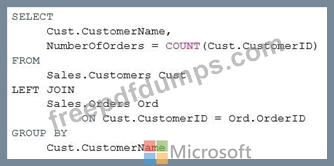
Does this meet the goal?
After you answer a question in this section, you will NOT be able to return to it. As a result, these questions will not appear in the review screen.
You have a database named DB1 that contains two tables named Sales.Customers and Sales.Orders.
Sales.Customers has a foreign key relationship to a column named CustomerID in Sales.Orders.
You need to recommend a query that returns all the customers. The query must also return the number of orders that each customer placed in 2016.
Solution: You recommend the following query:

Does this meet the goal?
070-761 Exam Question 54
You develop and deploy a project management application. The application uses a Microsoft SQL Server database to store data. You are developing a software bug tracking add-on for the application.
The add-on must meet the following requirements:
* Allow case sensitive searches for product.
* Filter search results based on exact text in the description.
* Support multibyte Unicode characters.
You run the following Transact-SQL statement:
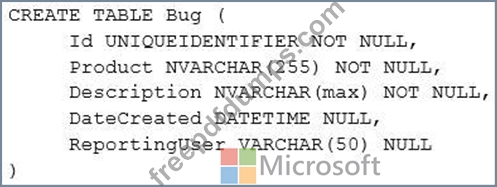
Users report that searches for the product Salt also return results for the product salt.
You need to ensure that the query returns the correct results.
How should you complete the Transact-SQL statement? To answer, select the appropriate Transact-SQL segments in the answer area.
NOTE: Each correct selection is worth one point.
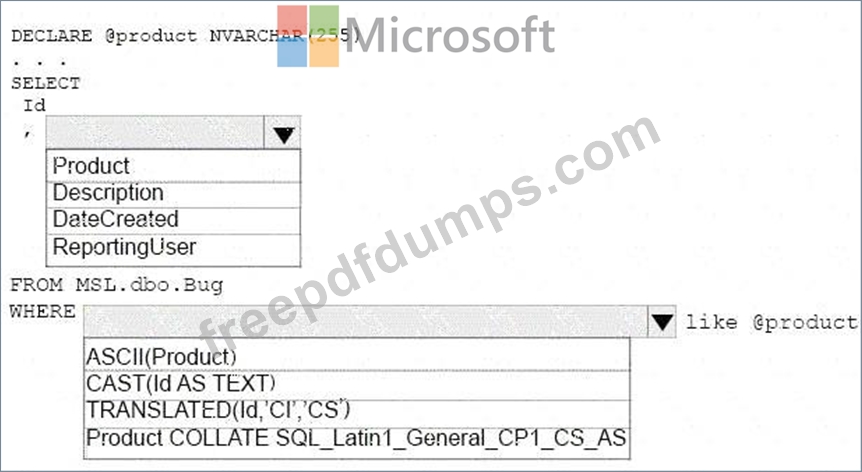
The add-on must meet the following requirements:
* Allow case sensitive searches for product.
* Filter search results based on exact text in the description.
* Support multibyte Unicode characters.
You run the following Transact-SQL statement:

Users report that searches for the product Salt also return results for the product salt.
You need to ensure that the query returns the correct results.
How should you complete the Transact-SQL statement? To answer, select the appropriate Transact-SQL segments in the answer area.
NOTE: Each correct selection is worth one point.

070-761 Exam Question 55
DRAG DROP
You have a database that contains the following tables:

A delivery person enters an incorrect value for the CustomerID column in the Invoices table and enters the following text in the ConfirmedReceivedBy column: "Package signed for by the owner Tim." You need to find the records in the Invoices table that contain the word Tim in the CustomerName field.
How should you complete the Transact-SQL statement? To answer, drag the appropriate Transact-SQL segments to the correct locations. Each Transact-SQL segment may be used once, more than once, or not at all. You may need to drag the split bar between panes or scroll to view content.
NOTE: Each correct selection is worth one point.
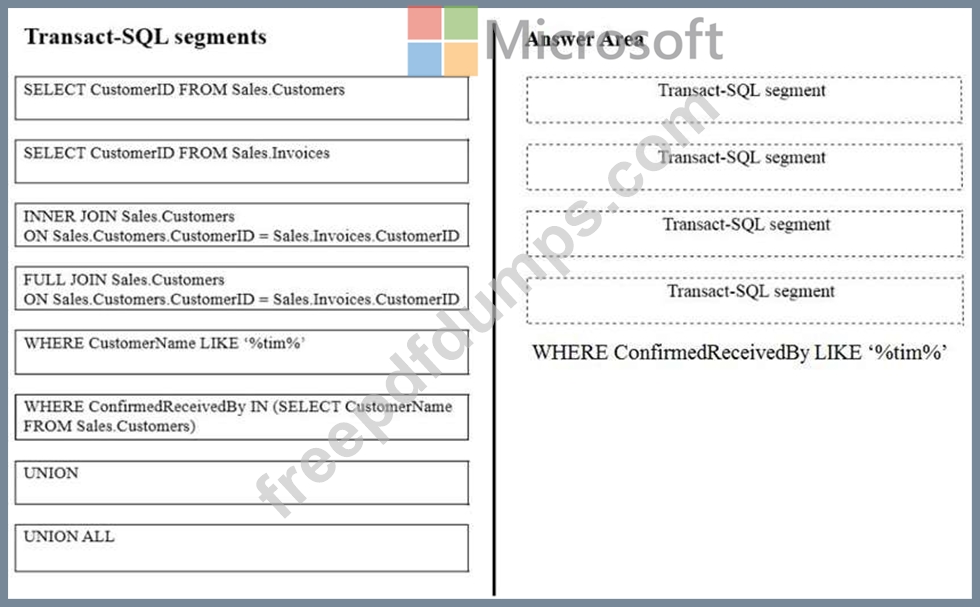
You have a database that contains the following tables:

A delivery person enters an incorrect value for the CustomerID column in the Invoices table and enters the following text in the ConfirmedReceivedBy column: "Package signed for by the owner Tim." You need to find the records in the Invoices table that contain the word Tim in the CustomerName field.
How should you complete the Transact-SQL statement? To answer, drag the appropriate Transact-SQL segments to the correct locations. Each Transact-SQL segment may be used once, more than once, or not at all. You may need to drag the split bar between panes or scroll to view content.
NOTE: Each correct selection is worth one point.



